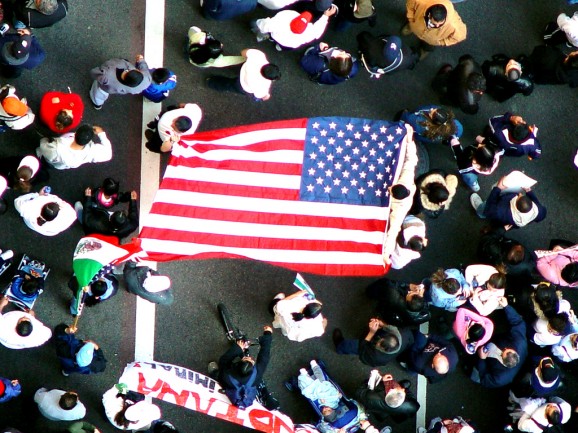Image: Joseph Vorves (CC by/nc/sa)
Change is a constant in the United States, including changes in population demographics. Whether it is immigrants arriving on our shores, or Americans moving from one part of the country to another, our history is full of people who are unsatisfied with their conditions, and who decide to settle somewhere else. As common as such change has been for centuries, though, when it happens rapidly, in ways that appear to upend longstanding social and cultural norms, it can easily produce a backlash. We are certainly seeing that today.
In our time, the issues of immigration and gentrification lead to fierce arguments, with both touching on sensitive subjects like race, class, community, jobs and money. Both trends are sadly effective at conjuring up stereotypes, whether of shiftless Hispanics stealing jobs from natives and making no effort to learn English, or callous white yuppies invading low-income black neighborhoods, jacking up prices with their expensive tastes, and forcing longtime residents to move. On some level, we know that these stereotypes are unfair, and that when we take a deep breath and step back for a more objective look, we will find these issues are a lot more complicated. But in the heat of an impassioned debate, it is all too easy to fall back on our presumptions, especially about people not like us and about whom we don’t really know all that much.
As things stand, though, there are significant similarities between immigration and gentrification, ones that are very easy to miss. Likewise, the criticisms of both trends have a lot in common. If we can grasp the similarities of both phenomena and both critiques, we have a better chance of lowering the temperature of debate around both issues.
Immigration has many of the same effects on conservative minds that gentrification has on progressive minds. For all the differences between them, there are two overarching similarities. First, both involve rapid demographic and cultural change that makes longtime residents uneasy (a natural human reaction.) Second, while both bring aggregate economic benefits, longtime residents do not always experience those benefits directly. Criticisms of immigration and gentrification each bring deep-seated concerns about belonging and norms to the surface. They also show that it can be unrealistic for defenders of change to rely on arguments that highlight economic gains. Anyone trying to convince a skeptic to question or abandon their skepticism will have to try something else–and so will anyone who wants to find common ground between advocates and critics of either demographic change.
Many progressives regard white criticism of immigration, and the description of undocumented immigrants as “illegal,” as racist. Whether this is due to the increasingly cosmopolitan outlook of the American left, or the presence of some genuinely racist elements on the fringe right, the accusation is an oversimplification at best. As Graeme Wood noted in an Atlantic article on German officials investigating asylum claims, if particular immigrants are proven to be in a country legally, a large amount of natives’ suspicion about them dissipates. Citing the work of sociologist Ariela Schachter, who found that native-born white Americans become more welcoming of immigrants when it’s proven they are in the US legally, Wood noted, “Some people who seem racist might just be extremely legalistic.”
To be sure, the legality of a person’s entrance into the United States has not always determined whether they are welcomed, either in the past or in the present. Journalist Julia Ioffe, herself a refugee from the former Soviet Union, was right to note in the New Republic in 2014 that America’s friendliness to immigrants varies wildly over time, and varies according to the categories into which immigrants fall. It might very well be the case that the ancestors of many modern immigration critics, if they showed up at a border crossing today, would not be allowed to enter the United States. All the same, progressives should not assume that ignorance of this reality is tantamount to bigotry. Unless a person actually knows whether their ancestors came to the country legally or not, he or she should not be automatically judged a bigot for insisting that restrictions on immigration be rigorously enforced.
There are ways in which immigration benefits the US economically. The Hamilton Project in 2018 reported that immigration, by bringing more people into the workforce, increases overall productivity. And while first-generation newcomers cost the federal government about $1,600 per person per year, according to the National Academies, their children on average contribute about $1,700 annually to the US economy. All of these are worth bearing in mind even while parsing more emotional arguments for and against immigration.
But not every American shares in the economic benefits. The increased presence of workers seeking low-skilled, low-paying jobs puts Americans without a high school diploma at a disadvantage. This gets to other progressive concerns, like racial and economic justice. Only about 8% of native-born American adults do not have a high school diploma. But they are disproportionately black and Hispanic. In 2017, according to the Census Bureau, 87% of blacks and 71% of Hispanics ages 25 and older had completed high school, compared to 94% of whites the same age. While the stereotypical images of immigration critics might be of working class whites complaining about immigrants taking “their” jobs, the people whose jobs are really at risk might actually be other people whose well-being progressives often care highly about. Immigration is an issue where progressive priorities clash.
It is easy to think of gentrification as a process by which affluent, highly educated whites come into areas that have long been home to low- or moderate-income blacks or Hispanics, drive up the costs of essentials like housing, impose their cultural tastes on the community, and force long-time residents to move. But the truth is far more complicated than that. Like the conservative who is quick to see immigration only as a force undermining the stability and culture of the United States, the progressive who sees only downsides to gentrification is not doing anyone a favor by oversimplifying.
While the immigration debate largely breaks down along red-blue lines, arguments over gentrification do not usually fit the same pattern. Because they often occur in major cities, they are essentially debates between different parts of the blue side. What both debates have in common, though, is that they pit the deep-seated human preference for stability against forces of change.
If red Americans knew more about the debates about gentrification blue Americans are having among themselves, they could better comprehend how and why progressives are so vehement in their defense of immigrants, even those who arrived in the country illegally. Likewise, if gentrification critics could compare their criticism of change in cities with conservatives’ wariness of immigration changing America as a whole, they might be less willing to criticize immigration skeptics. Each side might see that, in both cases, the concerns about big cultural and demographic shifts are not merely motivated by economic changes that can be calculated (lost jobs, high prices,) but by something harder to grapple with: natural human tendencies.
In 2016, the Washington Post published an article tackling myths about gentrification. Among them were the beliefs that gentrification inherently displaces people (“a neighborhood’s poverty rate could drop from 30 percent to 12 percent in a decade with minimal displacement”) and that gentrifiers were almost all white (“In many neighborhoods, middle-class Asians, blacks and Latinos are part and parcel of the process.”) Hence something the process has in common with immigration: the expectations of economic harm to residents do not line up with the objective reality.
To be fair, the common criticism of gentrification is not entirely without merit. As with immigration, the aggregate benefits of gentrification are accompanied by some costs. The Washington Post also reported this year that, unlike many other gentrifying cities, Washington DC is in fact experiencing high levels of dislocation. Specifically, people with lower incomes are moving from parts of the city that are booming economically, to parts that are in economic decline: “In portions of the Kingman Park and Capitol Hill neighborhoods, nearly 75 percent of the low-income populations have vanished, census information shows. In the Navy Yard neighborhood, about 77 percent of residents were identified as low income in 2000. Sixteen years later, that population dropped to 21 percent.”
Furthermore, even if gentrification does benefit a particular neighborhood economically, it is not surprising if some residents of that neighborhood feel unsettled or threatened by it. The role of real estate developers and government agencies, for example, in putting many urban black communities at an economic disadvantage – with practices like redlining and blockbusting – means it will not be surprising if some degree of backlash accompanies rapid change of the kind gentrification often brings. While distrust of gentrification is far from universal (the 2016 article also described the idea that “Longtime residents hate gentrification” as a myth,) the distrust that does exist is not unexpected.
The critics of immigration and gentrification parallel each other in that their criticism aligns with their belief in a sacred value. For the right, it is the nation, including the integrity of its borders. For the left, it is the well-being of the people they view as vulnerable. Any contentious issue like these – especially one that politicians on either side can exploit by getting people riled up – is bound to touch multiple nerves.
It is very noteworthy that both these major demographic shifts are often lamented by people who are not materially harmed by them. Vocal, visible immigration critics are typically middle class (whether that means blue collar, white collar, or some combination of the two,) not members of the vulnerable 8% who lack a diploma and compete with low-skilled immigrants for jobs. The parallel gap on gentrification is even starker: a lot of the lamentation comes from gentrifiers themselves, people bemoaning the advantages they have even as they benefit from them. Again, quantifiable measures of change like money are only part of the story.
Progressives can better comprehend conservative resistance to immigration by comparing it to what they imagine residents of gentrifying neighborhoods feel. Whether their beliefs about the latter are accurate or not, the fact that they can at least somewhat understand, and perhaps even agree with, the attitudes of someone who feels like a stranger in their own neighborhood means they can understand at least somewhat the feelings of someone who feels like a stranger in their own country. Similarly, conservatives can better understand progressives’ vehement defenses of undocumented immigrants, and the willingness of some to call support for deportation racist, by looking at many progressives’ willingness to believe gentrification is harming people. Seeing the conflicted reactions within blue metro areas need not (and should not) give red Americans cause for gloating, but rather cause for understanding why they are so passionate.
The forces of change riling America today will not dissipate anytime soon. Barring something completely unforeseen, immigrants will continue to arrive at the border, and gentrifiers will continue to arrive in urban neighborhoods. The only question is how those already present will react to their presence. The sooner we get inside the heads of people who don’t think like us on these contentious issues, the sooner we can move the tenor of our disagreements away from condemnation.




